Discover 15 hidden attractions, cool sights, and unusual things to do in Wigan (United Kingdom). Don't miss out on these must-see attractions: Museum of Wigan Life, Trencherfield Mill, and Wigan Parish Church. Also, be sure to include Mesnes Park in your itinerary.
Below, you can find the list of the most amazing places you should visit in Wigan (England).
Table of Contents
Museum of Wigan Life

Museum in Wigan, England. The Museum of Wigan Life is a public museum and local history resource centre in Wigan, Greater Manchester, England. The nineteenth-century listed building is by the noted architect Alfred Waterhouse. It originally housed Wigan Library, where George Orwell researched his book The Road to Wigan Pier in 1936.
The museum works with other museums in Greater Manchester as part of the Greater Manchester Museums Group (GMMG).[1]
Address: 41 Library St, WN1 1NU Wigan
Trencherfield Mill
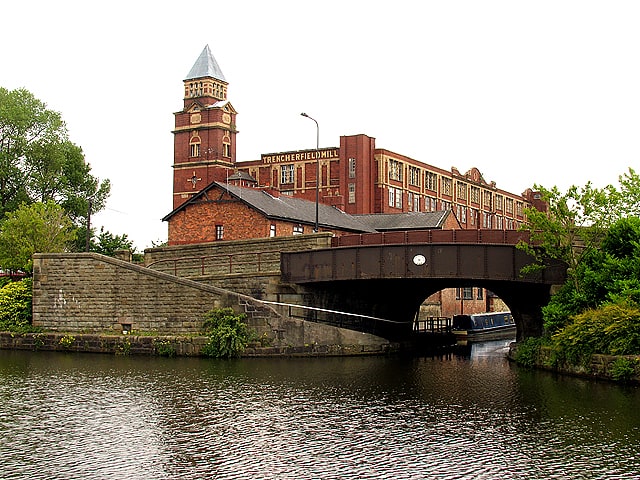
Historical place museum in Wigan, England. Trencherfield Mill is a cotton spinning mill standing next to the Leeds and Liverpool Canal in Wigan, Greater Manchester, England. It was built in 1907. It was taken over by the Lancashire Cotton Corporation in the 1930s and passed to Courtaulds in 1964. The mill was driven by a 2,500 hp triple-expansion four-cylinder engine built by J & E Wood of Bolton in 1907. The two halves of the engine were called Rina and Helen. They drove a 26-foot flywheel with 54 ropes at 68 rpm. The engine was stopped in 1968. The mill is now part of the Wigan Pier redevelopment area and is used for other purposes.[2]
Address: Trencherfield Mill Heritage Way, WN3 4BL Wigan
Wigan Parish Church

Church in Wigan, England. All Saints' Church in Wallgate, Wigan, Greater Manchester, England, is an Anglican parish church. It is in the deanery of Wigan, the archdeaconry of Warrington and the Diocese of Liverpool. The church is recorded in the National Heritage List for England as a designated Grade II* listed building, and stands on a hill in the centre of the town.[3]
Mesnes Park

Park in Wigan, England. Mesnes Park (English: is a Victorian public park dating from 1878 in Wigan, Greater Manchester, UK.
The elongated 12 hectares (30 acres) park lies to the north-west of Wigan town centre with its main entrance at the junction of Bridgeman Terrace and Mesnes Park Terrace. It comprises formal flower beds in grass lawns, a pool, children's playgrounds, mini golf, sports grounds and a café.
It has recently undergone a multi-million pound restoration after receiving a grant from the Heritage Lottery Fund.[4]
Address: Mesnes Park Mesnes Park Terrace, WN1 1TU Wigan
Worthington Lakes
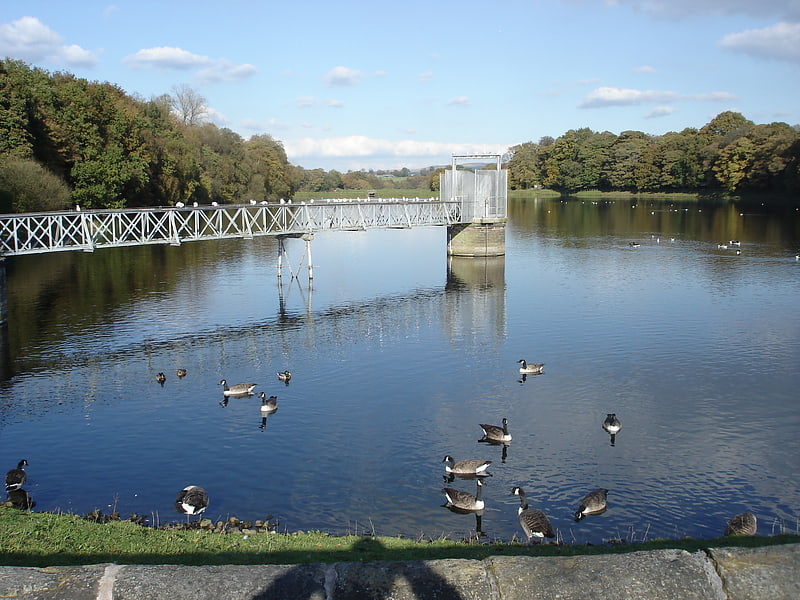
Reservoir in England. Worthington Lakes is a series of three reservoirs in Lancashire close to nearby Standish, off the A5106 Wigan to Chorley road in the north-west of England. They were constructed in the early 1860s to provide the clean water required by the rapidly growing town of Wigan.
Despite being situated in the Douglas Valley the water supply comes from the Parbold hills to the west as River Douglas was considered too polluted to be used for drinking water. The lakes, which are now in the ownership of United Utilities are today part of a 50-acre (20 ha) country park, with a nature reserve and accessible footpaths and used for informal recreation and for angling.
A transcript of the public information notice board provided by United Utilities reads:
By the mid 1800s the population of the Wigan area had increased to 30,000 and a crisis arose with increasing demand for clean accessible water.
As a result, a civil engineer, Mr. Rawlinson was commissioned by the local Board of Health to inspect and survey the country around Wigan and report on options for a new water supply scheme. The water course chosen starts to the east of Tunley Moss, becoming Stars Brook, Hic Bibi Brook and finally Buckow Brook before flowing into the River Douglas valley. This was chosen as a suitable site for the Worthington Reservoirs. Just to the northeast of the White Crow Inn, a conduit splits off to feed the Arley and Worthington Reservoirs, while the brook itself left to feed the must northerly Adlington Reservoir.
By 1858 the River Douglas was diverted through a tunnel to the east of the valley to enable work on two earth embankments and water treatment works to be started. The estimated cost for the works including diverted tunnel, treatment plant, 2 dams, mains and pumping station etc. was between £25,000 and £30,000.
Modifications to the site were needed due to a concern about flooding of mines along a geographical fault crossing the site and so another embankment was constructed (Adlington dam) along the fault line. The Douglas Tunnel had to be extended to give a greater capacity and Worthington Dam was created. An additional Act was required due to the extensive modifications at the site. In 1860 the Wigan Waterworks Act received Royal Assent and the works were then constructed. By 1867 the whole works were completed including connection to the distribution system of the Wigan areas.
The Arley and Worthington reservoirs had bypasses to enable them to be operated individually. When the reservoirs are low the earthenware pipeline along the side of the Arley reservoir and the cast iron pipeline along the Worthington reservoir are visible today.
The original treatment process was by slow sand filtration, flowing by gravity from the draw-off tower to the filter beds. The water was piped to a water tank at the foot of the dam and then to a second tank before flowing along a gravity trunk main down the Douglas Valley. The second tank can be seen today, a very long, low building with a pitched roof at the foot of the dam.
Worthington Reservoir when full is about 9 metres deep and has a capacity of 546 million litres. If required the water treatment works today could filter and chlorinate up to 8 million litres of water a day.[5]
Adam Viaduct

The Adam Viaduct is a grade II listed concrete underbridge in Wallgate, Wigan. The bridge, constructed in 1946, is the earliest prestressed concrete railway bridge in the United Kingdom, with only some examples in Switzerland being earlier. It is bridge number 54 on the Kirkby branch line and is at a line distance of 18 miles 1,032 yards.[6]
Haigh Hall
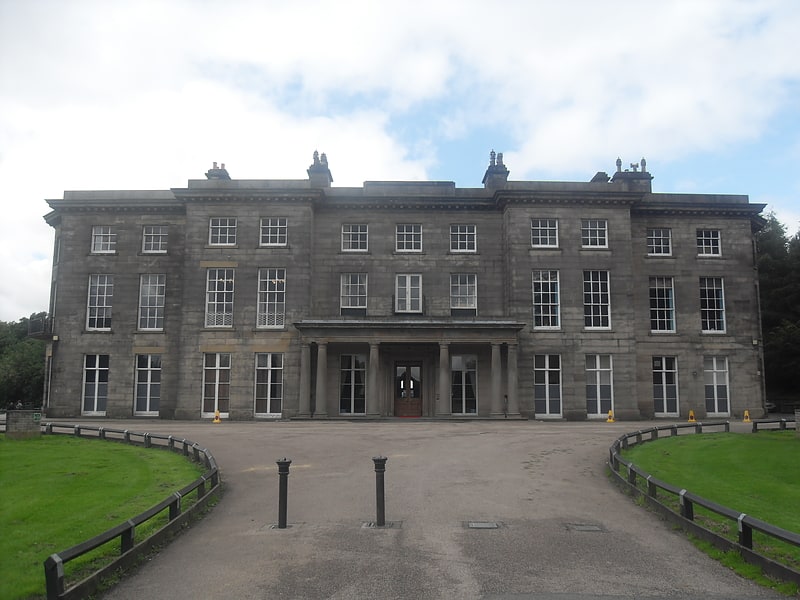
Housing. Haigh Hall is a historic country house in Haigh, Metropolitan Borough of Wigan, Greater Manchester, England. Built between 1827 and 1840 for James Lindsay, 7th Earl of Balcarres, it replaced an ancient manor house and was a Lindsay family home until 1947, when it was sold to Wigan Corporation. The hall is recorded in the National Heritage List for England as a designated Grade II* listed building and is owned by Metropolitan Borough of Wigan.[7]
Address: Wigan, Haigh, Greater Manchester, England
St John the Divine's Church
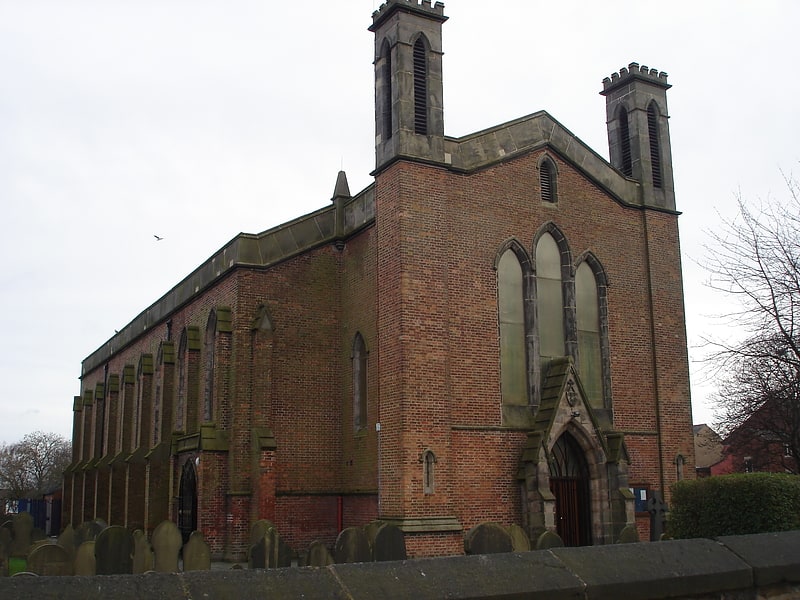
Anglican church in Wigan, England. St John the Divine's Church is in Church Street, Lamberhead Green, Pemberton, Wigan, Greater Manchester, England. It is an active Anglican parish church in the deanery of Wigan, the archdeaconry of Warrington, and the diocese of Liverpool. The church is recorded in the National Heritage List for England as a designated Grade II listed building. It was a Commissioners' church, having received a grant towards its construction from the Church Building Commission.[8]
Address: Church Street, Pemberton, Wigan
Wigan Town Hall

The new Town Hall is a former technical college in Library Street, Wigan, England which was converted into a municipal facility in 1990. It is a Grade II listed building.[9]
Address: Wigan Life Centre, The Wiend, WN1 1NH Wigan
St David's Church

Building. St David's Church is in Copperas Lane, Haigh, Wigan, Greater Manchester, England. It is an active Anglican parish church in the deanery of Wigan, the archdeaconry of Warrington, and the diocese of Liverpool. The church is recorded in the National Heritage List for England as a designated Grade II listed building. It was a Commissioners' church, having received a grant towards its construction from the Church Building Commission.[10]
Hindley

Town in England. Hindley is a town within the Metropolitan Borough of Wigan in Greater Manchester, England. Lying three miles east of Wigan it covers an area of 2,580 acres. Within the boundaries of the historic county of Lancashire, Hindley borders the towns and villages of Ince-in-Makerfield, Aspull, Westhoughton, Atherton and Westleigh in the former borough of Leigh. In 2001, Hindley had a population of 23,457, increasing to 28,000 at the 2011 Census. It forms part of the wider Greater Manchester Urban Area.[11]
St Matthew's Church
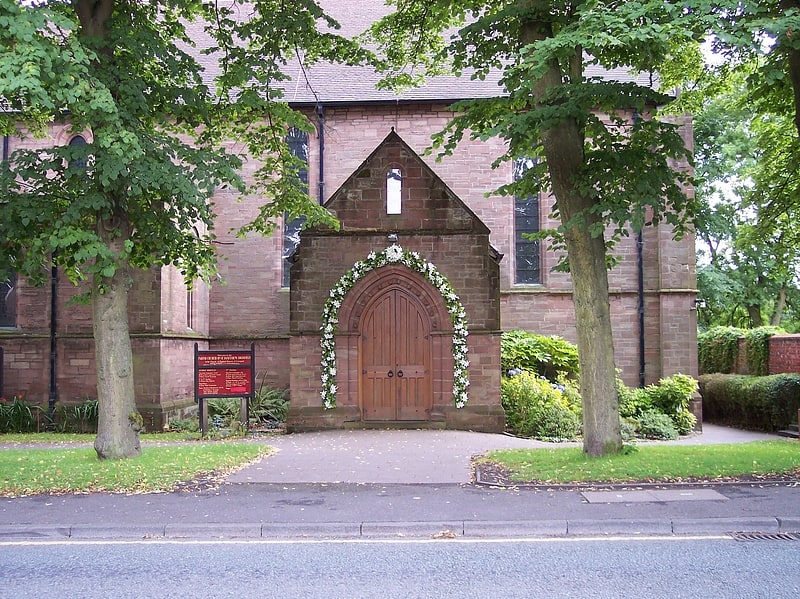
Church in Wigan, England. St Matthew's Church is in Billinge Road, Highfield, Pemberton, Wigan, Greater Manchester, England. It is an active Anglican parish church in the deanery of Wigan, the archdeaconry of Wigan & West Lancashire, and the diocese of Liverpool. The church is recorded in the National Heritage List for England as a designated Grade II* listed building.[12]
St Michael and All Angels' Church
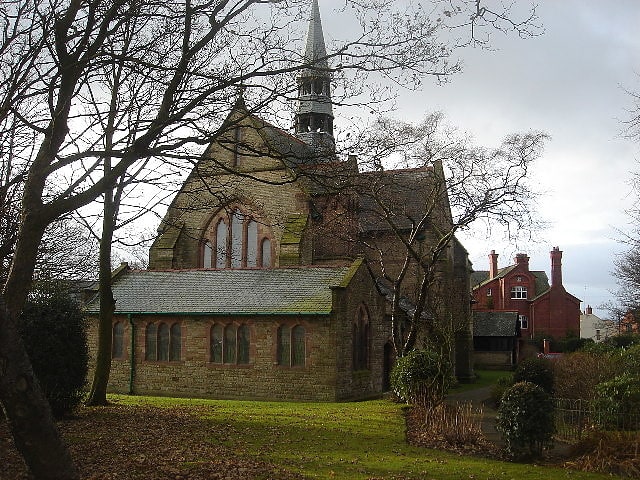
Church in Atherton, England. St Michael and All Angels' Church is in Leigh Road, Howe Bridge, a suburb of Atherton, Greater Manchester, England. It is an active Anglican parish church in the deanery of Leigh, the archdeaconry of Salford and the diocese of Manchester. Its benefice is united with those of three local churches, St John the Baptist, St George and St Philip, forming a team ministry entitled the United Benefice of Atherton and Hindsford with Howe Bridge. The church is recorded in the National Heritage List for England as a designated Grade II* listed building.[13]
Address: Leigh Rd, M46 0PH Manchester
St James' Church
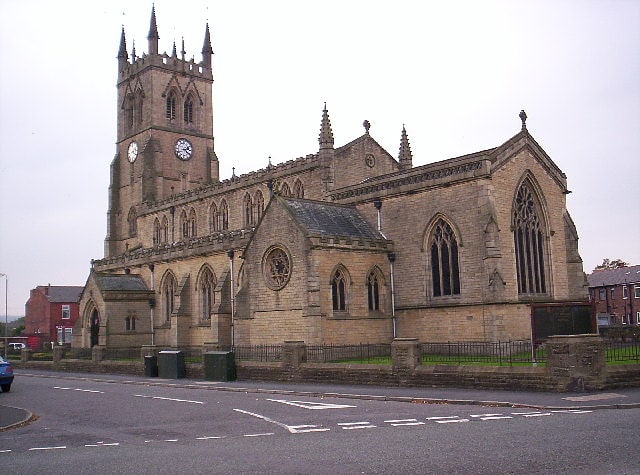
Building. St James' Church is in the Poolstock district of Wigan, Greater Manchester, England. It is an active Anglican parish church in the deanery of Wigan, the archdeaconry of Wigan & West Lancashire, and the diocese of Liverpool. The church is recorded in the National Heritage List for England as a designated Grade II* listed building.[14]
Address: 14 Hardman St, WN3 5EZ Wigan
St John's Church
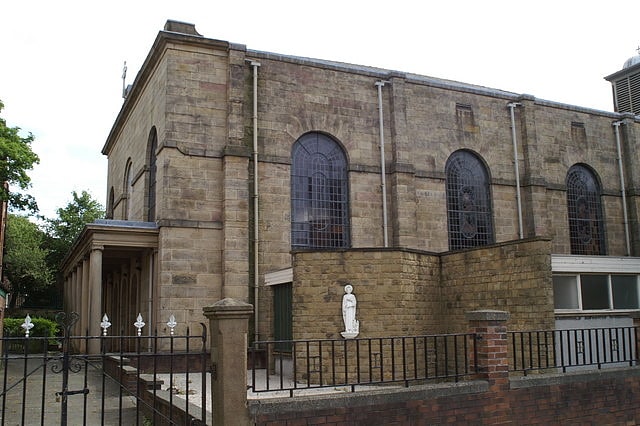
Church in Wigan, England. St John's Church is a Roman Catholic Church in Standishgate, Wigan, Greater Manchester. It is within 200 feet of another Catholic church, St Mary's. Construction on both churches, was done in a spirit of competition, so they both were finished in the same year, 1819. The competition was because St John's Church was originally served by the Society of Jesus, whereas St Mary's was always served by priests from the diocese. However, the Jesuits gave the church to the Archdiocese of Liverpool in 1933. It is a Grade II* listed building and the sanctuary inside the church was designed by Joseph John Scoles.[15]